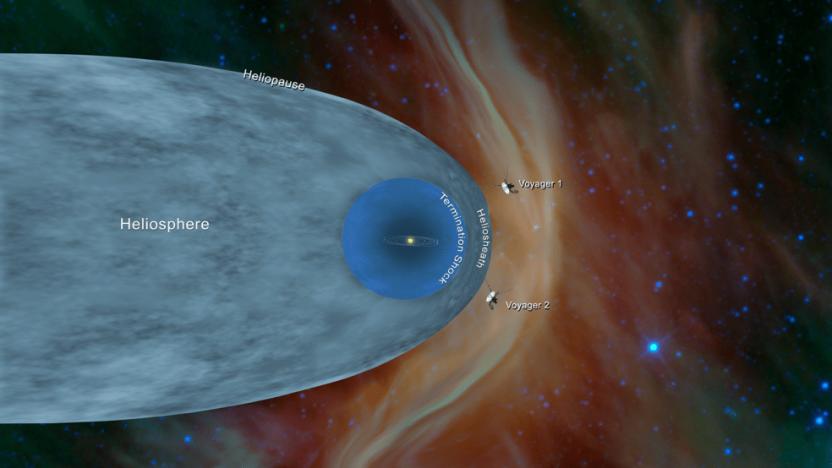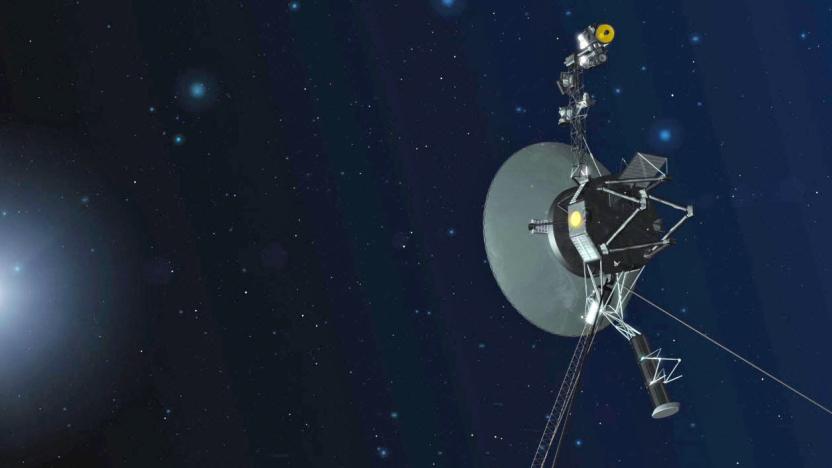voyager1
Latest

NASA’s Voyager 2 probe has entered interstellar space
NASA's Voyager 2 spacecraft has exited the heliosphere -- the plasma bubble created by the sun that encompasses most of our solar system -- and entered interstellar space, making it the second human-made object to do so. Voyager 1 hit this milestone in 2012. NASA said Voyager 2 crossed over the heliopause, the boundary between the heliosphere and interstellar space, on November 5th and the probe is now more than 11 billion miles from Earth.

NASA wakes up Voyager's slumbering thrusters 37 years later
NASA's Voyager 1 has been drifting farther and farther away from our planet for the past 40 years. Now, the agency has ensured that it can maintain contact with the farthest spacecraft from Earth for at least two to three more years by waking up a set of backup thrusters it hasn't used since 1980. Voyager needs to rotate itself every so often so that its antenna points to our planet. It orients itself by firing several 10-millisecond puffs with its thrusters -- problem is, the ones it regularly uses haven't been performing as well after four decades in space.

Study answers lingering questions about Voyager 1 in interstellar space
Three years ago, the American Geophysical Union said the Voyager 1 probe left the solar system. NASA quickly said nope, hold your horses, we're not there yet. Then, NASA announced a year later that yes, Voyager 1 really did make it. The debate still rages on in some pockets of the scientific community, but a new study out of the University of New Hampshire just pulled some solar wind out of detractors' sails.

NASA's Voyager 1 escapes our sun's warm embrace, becomes the first man-made device to enter interstellar space
NASA satellite Voyager 1, at 36 years young, is the first man-made object in recorded history to enter interstellar space. Moreover, it's apparently been doing so for around one year -- NASA scientists at the Jet Propulsion Laboratory announced as much this afternoon, and explained how they were tipped off. "We have an instrument on board which can measure the density of ions, the plasma which is out there," Voyager project scientist Ed Stone said in a prepared video. "In March of 2012, it turns out there was a massive eruption from the sun which eventually reached Voyager 1 in April of 2013. When that blastwave reached Voyager 1, it caused the plasma around Voyager to vibrate or oscillate in a certain particular tone. Literally the sounds of interstellar space." The satellite was originally launched in September 1977 in the interest of studying our own solar system as well as the interstellar medium. Having checked the first of those goals of its list, Voyager 1 is apparently head down on the second one. The satellite was thought to have reached interstellar space some time ago, but now NASA says it's really for sure. We wish it the best of luck exploring the icy void of space between solar systems. Remember to bring a towel!

AGU study says Voyager 1 has reached interstellar space, but NASA remains skeptical
It would be an understatement to say there's been a long build-up to the moment when Voyager 1 ventures into interstellar space: scientists thought the probe was on the edge back in 2010, and we've been waiting for the official milestone ever since. Researchers contributing to an American Geophysical Union journal now believe that the spacecraft may have crossed that symbolic border months ago. Measurements from August 25th onwards show a steep drop in the detected volume of cosmic rays from the heliosphere, just as the extrasolar rays are picking up. Spectrum measurements from the period also mirror those of interstellar regions. On the surface, the clues strongly imply that Voyager 1 has passed the limit of our solar system's influence. NASA, however, disputes the claims -- the agency notes that its vehicle is still traveling the magnetic highway, and it won't have officially escaped the surly bonds of the Sun until the magnetic fields shift. We won't break out the champagne and party streamers, then, but the dispute underscores just how close we are to having another human-made object roaming the galaxy.

NASA's Voyager 1 marks 35th anniversary of its launch, gets photo retrospective in tribute
It's hard to believe at times that the Voyager 1 probe is older than many of us reading this article, but it's true. The official first part of NASA's Voyager program launched just over 35 years ago on September 5th, 1977, carrying not just cameras and sensors to capture the trip but the famous Golden Record documenting humanity for any curious aliens. To mark the occasion, Wired has gathered together one heck of a photo album that covers both Voyager 1's trip as well as that of Voyager 2, which technically launched earlier (August 20th the same year) but took a more roundabout route through the solar system. The gallery reminds us of the amazing scenery beyond Mars and puts our tiny blue ball of a planet in perspective; Earth was just a speck at best when photographed late into Voyager 2's journey. Perhaps the best news surrounding the milestone is simply that both Voyager probes are still running. At 11 billion miles from the Sun, Voyager 1 may be on the cusp of interstellar space and easily represents the most distant human object ever made, not to mention a record-setter for signal transmissions. There's even a chance we'll still be hearing back from the probe for its 50th anniversary -- its power could keep it chatting up to roughly 2025.

Voyager 1 will exit solar system soon, is so close to the void it can taste it
Endurance: it's important in every race, including the space race, even though many pundits would argue that it kind of fizzled a long time ago. Thirty-three years prior to now, NASA's Voyager 1 began its journey to check in on the outer planets. It accomplished that goal in 1989, and has since moved on to bigger and better things -- you know, like leaving the solar system. Ten billion miles away, Voyager 1's Low-Energy Charged Particle Instrument is spitting out "solid zeroes," which means it's not detecting any more outward movement from solar winds. The heliopause (read: the official edge of the solar system) is just a few short years away for the radioactive-powered spacecraft, which is frightening to think about regardless of your experience in Space Camp. What will happen once it enters interstellar space? We're not sure, but we're trying to set up radio comms with its earth-bound synthesizer progeny for some kind of freaky space jam. We'll keep you posted. [Image courtesy NASA/JPL-Caltech]





